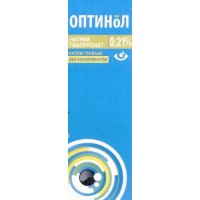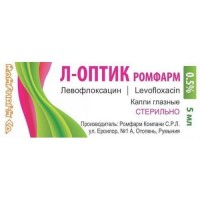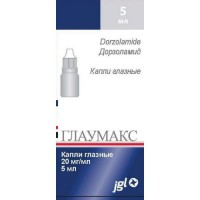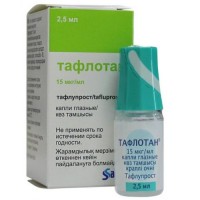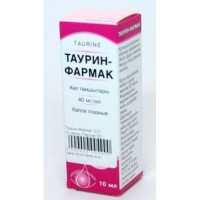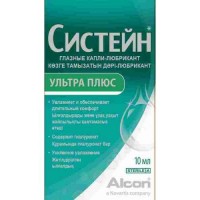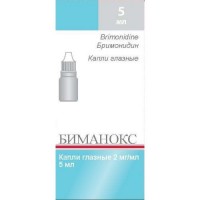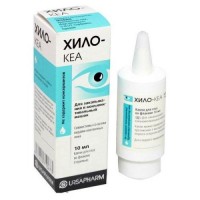Brineks 1% eye drops 5 ml of suspension
- $29.60
The instruction for medical use of Brinex Torgovoye medicine a name of Brinex the International unlicensed name Brinzolamid Lekarstvennaya the Drop form eye, suspension, 1.0%, 5 ml, 10 ml Structure of 1 ml of drug contains active agent - brinzolamid 10 mg, excipients: a benzalkoniya chloride, sodium chloride, dinatrium edetat, carbomer 974 P, Mannitolum, tiloksapol, sodium hydroxide, acid chlorohydrogen, water for injections. Description White or almost white suspension. Pharmacotherapeutic group Drugs for treatment of diseases of eyes. Protivoglaukomny drugs and miotik. Karboangidraza inhibitors. Brinzolamid. The ATX S01EC04 code the Pharmacological Pharmacokinetics At properties topical administration brinzolamid gets into a system blood stream, is well soaked up in intestines. Cmax in blood is defined in 2 hours. Collects in erythrocytes, about 33% contact proteins of blood plasma. The concentration of drug defined in blood plasma are much lower therapeutic than significant level. T1/2 makes 3 hours. As drug is adsorbed in erythrocytes, elimination half-life can make several months. It is removed with urine. Karboangidraz's pharmacodynamics (coal anhydrase) is the zinc-containing enzyme which is present at various body tissues including in kidneys and a ciliary body of an eye. Enzyme has intracellular localization and participates in process of hydration and dehydration of carbonic acid. There are several types of coal anhydrase, however the karboangidraza of II has the greatest activity. Both at local, and at system use, inhibitors of a karboangidraza cause decrease in VGD. The maximum hypotensive effect after Brinex's burying begins in 2 hours and remains within 12 hours. The maximum decrease in intraocular tension is 14-24% of initial level. Indications - an open angle glaucoma - an oftalmogipertenziya - as monotherapy at the patients who are not reacting to use of β-blockers or for patients to which β-blockers are contraindicated - as additional therapy to β-blockers or analogs of prostaglandins the Route of administration and doses the Route of administration to Stir up a bottle before the use! It is not necessary to touch with a pipette tip eyes or any other surface to avoid pollution of contents of a bottle. After use the bottle should be closed densely. After burying the lacrimonasal occlusion or cover is recommended a century. It reduces system absorption and an adverse effect of the medicine which is applied locally through eye tissues. When replacing other drug against glaucoma with eye drops of Brinex, it is necessary to stop intake of the replaced drug and to begin Brinex's reception next day. When using several ophthalmologic drugs of topical administration, it is necessary to observe an interval between burying at least 5 minutes. If administration of drug is missed, treatment should be continued by reception of the drug dose following according to the schedule. More than 3 drops a day in the affected eye are not recommended to take the drug. Doses At use as monotherapy or in the accompanying therapy of Brinex dig in on 1 drop twice a day in the lower conjunctival sac of the affected eye (eyes). To some patients 3 times a day recommend to dig in drug. Duration of treatment is defined by the attending physician. The dose Patients of advanced age of Adjustment of a dose at patients of advanced age is not required Patients with a liver and renal failure from patients of special groups the Use of drug was not studied at patients with abnormal liver functions therefore Brinex is not recommended for use for such persons. Brinex's use was not studied at patients with a heavy renal failure (with clearance of creatinine & lt, 30 ml/min.) or at patients with giperkhloremichesky acidosis. As brinzolamid and its main metabolite are allocated from an organism mainly with kidneys, Brinex is contraindicated to such patients. Patients of children's age Safety and Brinex's efficiency was not established at babies, children and teenagers aged from 0 up to 17 years. In this regard Brinex is not recommended for use at babies, children and teenagers. Side effects the Provided data on side reactions, were received from clinical trials and post-marketing spontaneous messages on a brinzolamida. These side reactions were registered at use of a brinzolamid (10 mg/ml, eye drops, suspension). They are classified according to the following symbols: very often (& gt, 1/10), it is frequent (& gt, 1/100 to & lt, 1/10), infrequently (& gt, 1/1000 to & lt, 1/100), is rare (& gt, 1/10000 to & lt, 1/1000), is very rare (& lt, 1/10000), or it is not known (it cannot be estimated on the available data). Side reactions are provided in decreasing order of gravity in each group. On the systems of bodies: Infections and invasions - infrequently: nasopharyngites, pharyngitises, sinusitis - it is unknown: rhinitises of Disturbance of blood and lymphatic system - infrequently: reduction of quantity of red blood cells, disturbance of electrolytic balance of blood Disturbance of the immune system - is unknown: a hyper sensitization of Disorder of metabolism and food - it is unknown: a loss of appetite Mental disorders - infrequently: apathy, a depression, depressive mood, decrease in a libido, nervousness - it is rare: insomnia Disturbance of nervous system - infrequently: motive disorders, amnesia, dizziness, paresthesias, a headache - it is rare: the memory impairment, drowsiness - is unknown: a tremor, giposteziya, loss of taste of Disturbance from eyes - it is frequent: misting of sight, irritation, feeling of a foreign body in an eye, eye hyperaemia - infrequently: the cornea erosion, a keratitis, a dot keratitis, a keratopathy, defects of an epithelium of a cornea, blepharitis, an itching of an eye, conjunctivitis, meybomiit, a photophobia, pterygium, pigmentation of a sclera, an asthenopia, visual discomfort, unpleasant feelings in an eye, a dry keratoconjunctivitis, conjunctival follicles, inadequate vision, hyperaemia of a conjunctiva, an itching in centuries, dacryagogue, a crust on an edge of the lids - is rare: swelled corneas, a diplopia, decrease in visual acuity, a photopsia, giposteziya, periorbital swelled, increase in VGD, excavation of an optic nerve - is unknown: a keratopathy, disorders of vision, an eye allergy, madaroz, reddening an age of Disturbance from an organ of hearing - is rare: a ring in ears - it is unknown: Disturbance dizziness from a cardiovascular system - infrequently: cardiorespiratory disturbances, bradycardia, heartbeat - it is rare: stenocardia, disturbance of heart rate - it is not known: arrhythmia, tachycardia, disturbances of arterial blood pressure of Disturbance from respiratory organs - infrequently: dispnoe, nasal bleeding, a sore throat, a stethalgia, irritation in a throat, cough, a rhinorrhea, sneezing - is rare: bronchitis, congestion of a nose and bosoms of a nose, cough, dryness in a nose - it is not known: asthma Gastrointestinal disorders - it is frequent: a dysgeusia - infrequently: an esophagitis, a diarrhea, nausea, vomiting, dyspepsia, pain in an upper part of an abdominal cavity, gastrointestinal discomfort, a meteorism, paresthesias and giposteziya in an oral cavity, dryness in a mouth of Disturbance of a gepato-biliary system - it is not known: disturbances of hepatic tests of Disturbance of skin and hypodermic – fatty tissue - infrequently: rash, spotty and papular rashes - it is rare: urticaria, an alopecia, a widespread skin itching - it is not known: dermatitis, the Disturbance erythema from a musculoskeletal system and connective tissue - infrequently: a dorsodynia, muscular spasms, myalgias - it is not known: an arthralgia, the Disturbance extremity pain from a secretory system - infrequently: renal pain - it is not known: the Disturbance pollakiuria from a reproductive system - infrequently: erectile dysfunction the General disturbances - infrequently: pain, discomfort in breasts, unusual feelings - it is rare: a stethalgia, nervousness, an asthenia, irritability - it is not known: peripheral swell, an indisposition of the Injury, poisoning and procedural complications - infrequently: feeling of a foreign body in a Contraindication eye - hypersensitivity to any component of drug - the known hypersensitivity to streptocides - closed-angle glaucoma - serious violations of function of kidneys - a heavy liver failure - giperkhloremichesky acidosis - pregnancy and the period of a lactation - children's and teenage age up to 18 years the Medicinal interactions Are undesirable combinations to the following medicines: - methylxanthines (Euphyllinum) – potentiation of diuretic effect, - ammonium chloride and other, acid-forming diuretics – reduction of diuretic effect. At a combination to cholinergic drugs and β-adrenoblockers strengthening of hypotensive effect concerning VGD is possible. Brinex is inhibitor of carboanhydrase and at topical administration there is its system absorption. Acid-base disturbances were registered at use of oral forms of inhibitors of a karboangidraza. Patients should mean a possibility of these disturbances, receiving Brinex. At the patients accepting at the same time inhibitor karboangidraz and Brinex, the additional system effect which is shown at use of inhibitors karboangidraz can be observed. At the same time, Brinex is streptocide. There can be side reactions characteristic of streptocides. In case of serious reactions or hypersensitivity the drug phase-out is recommended. The isoenzymes of R-450 cytochrome responsible for metabolism of a brinzolamid include CYP3A4 (main), CYP2A6, CYP2C8 and CYP2C9. It is possible that CYP3A4 inhibitors, such as ketokonazol, itrakonazol, Clotrimazolum, ritonavir and troleandomitsin will break metabolism of a brinzolamid due to accumulation of CYP3A4. It is necessary to be careful if CYP3A4 inhibitors are applied along with Brinex. Nevertheless, accumulation of a brinzolamid is improbable as, generally he is brought by kidneys. Brinzolamid is not inhibitor of isoenzymes of R-450 cytochrome. Special instructions and precautionary measures when using System effects of Brinex is sulfonamide, inhibitor of a karboangidraza and though it is applied locally, it is absorbed systemically. In this regard and at topical administration of streptocides, similar types of side reactions can be shown. If there are signs of serious reactions or hypersensitivity, it is necessary to stop use of this drug. At use of oral forms of inhibitors of a karboangidraza, acid-base disturbances were registered. Therefore to patients with risk of a renal failure, it is necessary to use Brinex with care as the risk of a metabolic acidosis is possible. Use of a brinzolamid was not studied at premature children (less than 36 weeks of a gestation) and also at children, 1 weeks of life are younger. Patients with essential immaturity or anomalies of renal tubules have to receive brinzolamid only after the careful analysis of balance of the expected advantage of drug and possible risk of a metabolic acidosis. The karboangidraza inhibitors applied orally can break ability to carry out the tasks demanding clarity of thinking and/or physical coordination. Brinex it is adsorbed systemically and, therefore, it can occur at its route of administration. The accompanying therapy At the patients receiving karboangidraza inhibitors orally and Brinex at the same time exists an opportunity for additive effect of the known systemic actions of inhibitors karboangidraz. The accompanying Brinex's introduction and oral inhibitors karboangidraz is not studied and is not recommended. As adjuvant therapy of glaucoma the interaction of a brinzolamid, first of all with additional introduction with Timololum was studied. Besides, use of a brinzolamid as additional hypotensive therapy to prostaglandin analog a travoprost was investigated. However, long-term data on use of a brinzolamid as additional therapy to a travoprost are not available. There is a limited experience of use of a brinzolamid in treatment of patients with pseudo-exfoliative or pigmentary glaucoma. Therefore at treatment of these patients it is necessary to apply Brinex with care and careful control of intraocular pressure is recommended. Brinex's use was not studied at patients with a narrow angle glaucoma therefore his use is not recommended at these patients. The possible role of a brinzolamid on function of a corneal endothelium at patients with cornea pathology is not investigated (especially at patients with low quantity of endothelial cells). Combination of carrying contact lenses and Brinex's use was not studied. Careful monitoring of these patients and careful use of Brinex by such patients as inhibitors karboangidraz can affect humidity of a cornea is recommended, and use of lenses in this case increases risk of defeat of a cornea. Brinex contains preservative a benzalkoniya chloride which can be absorbed by soft contact lenses and decolour them and also can cause irritation of eyes. Therefore it is recommended to remove lenses before burying eye drops of Brinex and to insert not earlier than in 15 minutes after burying. It is impossible to apply Brinex over contact lenses. At the same time it is known that the benzalkoniya chloride which is usually used as preservative in ophthalmologic products can be the reason of a keratopathy and dot keratitis. As Brinex the benzalkoniya contains chloride, careful control at frequent or its long use from patients with "a syndrome of a dry eye" is required. The potential effect of prolongation of action after phase-out of Brinex is not studied, it is known only that the hypotensive effect will last for 5-7 days. Use for children Safety and efficiency of use of eye drops of Brinex for patients is younger than 18 years is not established therefore use of drug for this group of patients is not recommended. Pregnancy and a lactation of Researches on use of Brinex for pregnant women it was not carried out. Eye drops of Brinex are recommended to be applied to pregnant women only if the expected advantage of its use considerably exceeds potential risk. Use of eye drops of Brinex is not recommended to the women nursing. Diabetes Is recommended careful control of a condition of a cornea at use of eye drops of Brinex for patients with diabetes. Features of influence of medicine on ability to run the vehicle or potentially dangerous mechanisms As well as in a case with other eye drops, after burying the temporary ambiguity of sight or other visual concerns is possible that it can negatively affect ability to drive the car or other potentially dangerous mechanisms. In this case it is necessary to wait some time before complete recovery of sight. Overdose it is not known of overdose cases this drug. Symptoms: disturbance of electrolytic balance, development of acidosis, disturbance from nervous system. Treatment: symptomatic. Control of level of serumal electrolytes (especially potassium), sizes rn is necessary for blood. A form of release and packing On 5 ml or 10 ml of drug in a plastic bottle with a cover dropper and the screwing-up cap of orange color. On 1 bottle together with the instruction for medical use in the state and Russian languages place in a pack cardboard. To Store storage conditions at a temperature of 4 °C - 30 °C. To store out of children's reach! A period of storage 2 years the use Period after opening of a bottle 4 weeks. Not to use after the expiry date specified on packing! Prescription status According to the prescription of Producer/Upakovshchik SENTISS FARM Pvt. Ltd., 212/D-1, Greene Park, New Delhi, India At the plant: Villidzh Khera Nikhla, Tekhsil Nalagarkh, Region of Solan, Himachal Pradesh 174,101, India Holder of the registration certificate of SENTISS FARMA of Pvt. Ltd., India the Address of the organization accepting claims from consumers on quality of products in the territory of the Republic of Kazakhstan: Republic of Kazakhstan, 050000, Almaty, Bogenba St.
of the Batyr 132, office 309. Ph./fax: +7 (7272) 96-45-99, Email: sentiss_kz@land.ru the Address of the organization responsible for post-registration observations of safety of medicine in the territory of the Republic of Kazakhstan: Republic of Kazakhstan, 050000, Almaty, Bogenbay St. of the Batyr 132
to Develop
of the Batyr 132, office 309. Ph./fax: +7 (7272) 96-45-99, Email: sentiss_kz@land.ru the Address of the organization responsible for post-registration observations of safety of medicine in the territory of the Republic of Kazakhstan: Republic of Kazakhstan, 050000, Almaty, Bogenbay St. of the Batyr 132
to Develop

